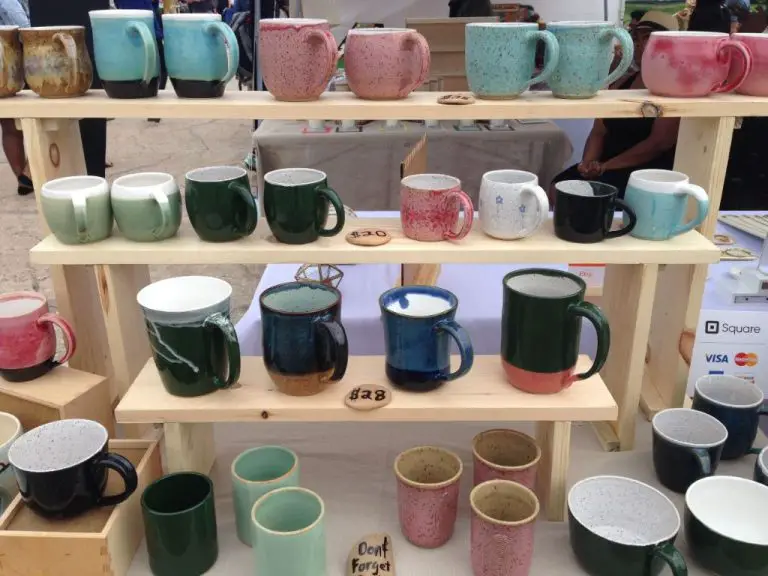Are Ceramic Mugs Worth It?
Ceramic mugs are drinking vessels made from clay that has been shaped and then fired at high temperatures to harden it. Ceramic mugs have become popular choices over standard glass or plastic mugs due to certain beneficial properties.
However, ceramic mugs also have some downsides to consider. This article will examine the pros and cons of ceramic mugs, looking at factors like heat retention, durability, flavor impact, environmental footprint, and cost to help determine if they are worth the investment over other mug materials.
Pros of Ceramic Mugs
Ceramic mugs have several advantages that make them a popular choice for hot and cold beverages. One of the main benefits is that ceramic retains heat extremely well. The porous nature of ceramic allows it to absorb heat and retain it for much longer than materials like glass or plastic. This keeps drinks hotter for longer (source).
Ceramic is also inert, meaning it does not impart any flavors or odors to drinks. This allows the natural taste of the beverage to shine through without interference from the mug material. Ceramics like stoneware and porcelain are non-porous, making it easy to clean any residual odors or tastes (source).
Compared to materials like glass or plastic, ceramic mugs are extremely durable and resistant to cracks, scratches and stains. With proper care, a ceramic mug can last for many years or even decades. Dropping a ceramic mug likely won’t shatter it like glass, making ceramics safer and more long-lasting.
Finally, ceramic mugs are an eco-friendly choice since they can be used for years before needing replacement. Ceramics are made from natural materials like clay and minerals that are abundantly available. Provided any decorations or glazes are non-toxic, ceramic mugs are a sustainable option.
Cons of Ceramic Mugs
While ceramic mugs have their benefits, they also have some drawbacks to consider (Advantages And Disadvantages Of Ceramic Mugs):
Ceramic mugs tend to be heavier than mugs made from materials like plastic or glass. This extra weight can make ceramic mugs more difficult to lift and carry, especially for extended periods.
The material is also relatively fragile. Ceramic mugs can chip or break if dropped or impacted, unlike more durable options like stainless steel.
Longer cool down times are another downside of ceramic. The thick material retains heat well, which is beneficial for keeping drinks hot. However, it takes longer for ceramic mugs to cool down after washing, requiring extra care when handling to avoid burns.
Finally, ceramic mugs tend to be more expensive than disposable paper or plastic cups. They also usually cost more than glass or plastic reusable mugs. The higher price point makes ceramics less ideal for large events or situations where breakage is likely.
Heat Retention
One of the key benefits of ceramic mugs is their excellent heat retention capabilities. The thick walls and dense material of ceramic mugs retain heat extremely well compared to materials like plastic or glass. As one manufacturer notes, “The thick walls of ceramic ensure that your beverage stays hot for a long time” (source).
Drinks like coffee, tea, and hot chocolate taste best when served hot. A ceramic mug will keep these beverages hotter for longer compared to other materials. You can savor and leisurely enjoy your hot drink without having to reheat it multiple times. This makes ceramic mugs ideal for drinks you want to slowly drink and appreciate.
The heat retention properties of ceramic stem from its thickness and density. Ceramic is able to absorb and retain more heat energy compared to thinner materials. It also conducts heat more slowly, meaning it will release the heat at a gradual pace to keep your drink at an ideal hot temperature for longer.
Durability
Ceramic mugs are known for their durability and ability to withstand repeated use without wear and tear. Unlike glass or plastic mugs, ceramic mugs won’t easily crack or shatter if dropped. The clay material is fired at extremely high temperatures, making it very strong and resistant to chipping and scratches. According to Monterey Company, ceramic mugs can last for many years with proper care and handling.
The durable nature of ceramic allows mugs to be washed frequently in the dishwasher without sustaining damage. Ceramic mugs won’t warp, bend or lose their shape over time. As long as the mug isn’t dropped from a significant height onto a hard surface, it should remain intact with daily use. This makes ceramic an ideal material for coffee and tea drinkers who want a mug that can withstand frequent washing and long-term use.
Taste and Odor
One of the benefits of ceramic mugs is that they do not retain tastes or odors. The glazed surface of a ceramic mug stays neutral and does not absorb any flavors from the beverages placed inside. This makes ceramic mugs a great choice for coffee, tea, or any other drink you want to taste pure and fresh every time.
Ceramic is an inert material that does not impart any unwanted flavors into your drink. Unlike plastic or metal, it will not make your coffee taste metallic or your tea taste plasticky. The neutral surface is ideal for sensitive taste buds.
Users on Reddit have complained about some ceramic mugs having an “earthy” or “dusty” taste at first. This may be due to traces of clay or glaze ingredients. However, a good quality ceramic mug that is properly fired and glazed should not retain any unwanted tastes or odors with regular use [1].
Overall, ceramic mugs are a great choice for enjoying your beverages without any interference in the natural taste.
Environmental Impact
Ceramic mugs are much more environmentally friendly than disposable cups because they are reusable and durable, lasting for many years. Unlike paper or plastic cups that get thrown away after one use, ceramic mugs reduce waste over their lifetime. According to a Stanford University study, American coffee consumption generates over 25 billion disposable cups per year, resulting in greenhouse gas emissions equal to 4 million cars. Reusable mugs eliminate this waste and carbon footprint.

Ceramic mugs are often made from natural clay that requires less processing and energy than paper or plastic production. Clay is an abundant natural resource that is dug from the earth and shaped into mugs. The glazes used to decorate mugs are also made from natural ingredients like minerals and metal oxides. Compared to the oil-based plastics and bleached papers used in disposable cups, clay mugs have a much smaller environmental impact from material extraction through production.
By switching to reusable ceramic mugs, people can greatly reduce the waste and carbon emissions caused by disposable cups. Mugs are the more sustainable choice for enjoying beverages without harming the environment.
Downsides to Consider
While ceramic mugs have their benefits, there are some downsides to keep in mind as well. Ceramic mugs tend to be heavier than mugs made from materials like plastic or glass. The weight of a ceramic mug when full can make it more difficult to carry and increases the chance of spilling. Ceramic is also prone to chipping or breaking if dropped, especially onto a hard surface like a tile floor. According to https://coffeemugcollection.com/pros-cons-of-ceramic-mugs/, rapid temperature changes can also cause cracking in ceramic.
To avoid damage, ceramic mugs should always be hand washed. They cannot withstand the high heat and harsh detergents used in dishwashers. The material is porous, so food and beverage stains can set in if not washed promptly. Hand washing takes more time and care than tossing mugs in the dishwasher.
While ceramic mugs have excellent heat retention and an appealing look and feel, their potential to chip, crack or break means they require a bit more care and caution than other mug materials. Weighing the pros and cons can help determine if ceramic is the right choice based on your priorities and how the mugs will be used.
Cost Comparison
When considering the cost of a ceramic mug versus other materials like glass, plastic, and paper, there are a few factors to analyze:
Ceramic mugs tend to have a higher upfront cost. Handmade ceramic mugs can range from $30-50 CAD according to ceramic artists on Reddit (source). Machine-made ceramic mugs from major retailers are typically $10-25.
In comparison, glass mugs are around $10-15, plastic mugs $5-15, and paper mugs under $1 (source).
However, with proper care, ceramic mugs can last for many years or even decades, providing great lifetime value. Other mug materials like glass, plastic, and paper tend to degrade, crack, or leach chemicals over repeated use. Replacing them adds up in cost over time.
For those who treasure artistry and quality drinkware, ceramic mugs can be worthwhile despite the higher initial investment. The unparalleled longevity and craftsmanship make ceramic a standout choice for mugs.
Conclusion
To summarize, ceramic mugs have several pros and cons to consider:
Pros:
- Excellent at retaining heat to keep drinks hot
- Very durable and long-lasting
- Can enhance taste and smell of beverages
- More environmentally friendly than disposable cups
Cons:
- Heavier than other materials like plastic or glass
- Can break if dropped
- More expensive upfront cost
Overall, ceramic mugs are a smart investment if you are a frequent coffee or tea drinker. The ability to keep drinks hot for longer, as well as the durability and eco-friendly nature of ceramic make these mugs worthwhile for daily use. People who only occasionally drink hot beverages may be better off using cheaper disposable cups or mugs. But for anyone who loves sipping their morning coffee or afternoon tea, a good ceramic mug is certainly worth the price.





